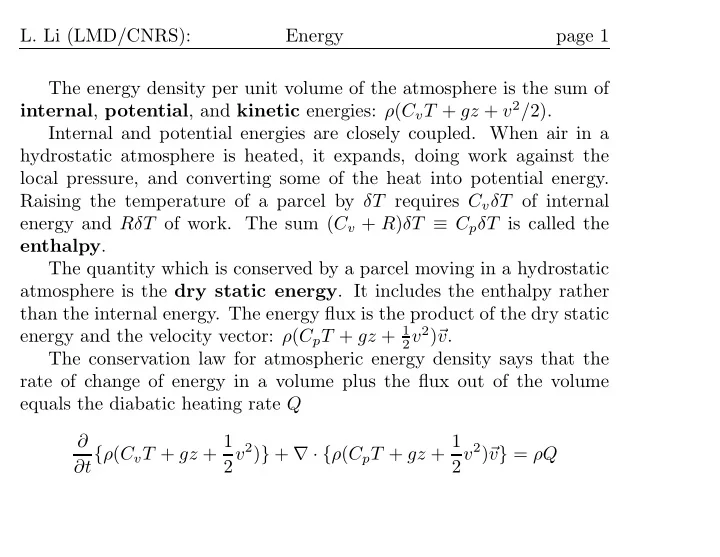

L. Li (LMD/CNRS): Energy page 1 The energy density per unit volume of the atmosphere is the sum of internal , potential , and kinetic energies: ρ ( C v T + gz + v 2 / 2). Internal and potential energies are closely coupled. When air in a hydrostatic atmosphere is heated, it expands, doing work against the local pressure, and converting some of the heat into potential energy. Raising the temperature of a parcel by δT requires C v δT of internal energy and RδT of work. The sum ( C v + R ) δT ≡ C p δT is called the enthalpy . The quantity which is conserved by a parcel moving in a hydrostatic atmosphere is the dry static energy . It includes the enthalpy rather than the internal energy. The energy flux is the product of the dry static energy and the velocity vector: ρ ( C p T + gz + 1 2 v 2 ) � v . The conservation law for atmospheric energy density says that the rate of change of energy in a volume plus the flux out of the volume equals the diabatic heating rate Q ∂t { ρ ( C v T + gz + 1 ∂ 2 v 2 ) } + ∇ · { ρ ( C p T + gz + 1 2 v 2 ) � v } = ρQ
L. Li (LMD/CNRS): Energy page 2 Energy budget of the Earth and conversion of heat in different forms. The greenhouse effect of the atmosphere is due to its particular radiative properties: almost transparent for solar radiation, but almost opaque for the infrared terrestre radiation.
L. Li (LMD/CNRS): Energy page 3 Radiative budget at the top of the atmosphere
L. Li (LMD/CNRS): Energy page 4 Zonally and annually averaged of vT
L. Li (LMD/CNRS): Energy page 5 Vertical integration of vT , annual average total mean transient stationary
L. Li (LMD/CNRS): Energy page 6 Zonally and annually averaged of vZ
L. Li (LMD/CNRS): Energy page 7 Vertical integration of vZ , annual average total mean transient stationary
L. Li (LMD/CNRS): Energy page 8 Zonally and annually averaged of vq
L. Li (LMD/CNRS): Energy page 9 Vertical integration of vq , annual average total mean transient stationary
L. Li (LMD/CNRS): Energy page 10 Zonally and annually averaged of vE
L. Li (LMD/CNRS): Energy page 11 Vertical integration of vE , annual average total mean transient stationary
L. Li (LMD/CNRS): Energy page 12 Vertical integration of E transport, annual average
L. Li (LMD/CNRS): Energy page 13 Vertical integration of q transport, annual average
L. Li (LMD/CNRS): Energy page 14 Divergence of E transport and q transport, annual average
Recommend
More recommend